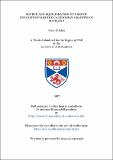Files in this item
Source and equilibration studies of xenoliths from the Caledonian granites of Scotland
Item metadata
| dc.contributor.advisor | Stephens, W. E. | |
| dc.contributor.author | Holden, Peter | |
| dc.coverage.spatial | 320 p. | en_US |
| dc.date.accessioned | 2018-07-17T10:36:04Z | |
| dc.date.available | 2018-07-17T10:36:04Z | |
| dc.date.issued | 1987-07 | |
| dc.identifier.uri | https://hdl.handle.net/10023/15474 | |
| dc.description.abstract | The origin of the dark microdioritic inclusions within I-type granitoids has been the subject of much debate and speculation. These 'xenoliths' have been variously ascribed to restite or cognate crystallisation (autoliths), wall rocks (accidental xenoliths), exotic (mantle) magmas and immiscible liquids. The object of this study was to test between these potential sources of inclusions and processes and to investigate whether such inclusions can be used to provide information on the petrogenesis of the host pluton and the nature of the source region(s) as well as processes of compositional zoning. The approach used was to study inclusions and their host rocks from three zoned plutons in the Caledonian of Scotland, namely Strontian, Ballachulish and Criffell. These were investigated petrographically, by whole rock major and trace element analysis and by Sr and Nd isotopes. Interpretation of the equilibration between inclusion and host benefitted from theoretical considerations of diffusion. It was found that for most 'igneous' inclusions Sr isotopes had thoroughly equilibrated, hosts and inclusions normally having identical Sr initial ratios. However the microdioritic inclusions normally retain a more primitive signature in their Nd isotopes (normally up to +2 Nd units greater than the host) precluding cognate, restite or immiscibility origins and are quite different from local country rocks. Most 'igneous' inclusions thus appear to have an exotic source of more primitive composition, presumably the upper mantle. The appinites of the Strontian pluton were also investigated as part of a study of coexisting acid-basic melts in granitoid plutons. It is shown that these appinites have quenched liquid contacts with the granitoid hosts and some degree of mixing between appinitic magma and host granitoid has given rise to a reverse zonation pattern in composition and texture. The isotopic data for the appinites of Strontian and for inclusions and their host granitoids in the Strontian and Criffell plutons point to a model for the initiation of granitoid magma genesis in the crust by advection of heat through transfer of basaltic magma from the upper mantle. Some of this magma is incorporated in the granitoid magma as basaltic inclusions which gradually become modified towards dioritic compositions. The characteristics of this mantle derived magma and the granitoid crustal source do not vary significantly between Strontian and Criffell in terms of Nd isotope model ages. This is a remarkable finding considering the very different tectonic settings and suggests greater similarities at deeper lithospheric levels. The study of Nd isotopes in xenolithic inclusions in granitoids has been shown to provide at least as much additional information on the petrogenesis of granitoid plutons as the conventional study of their host rocks, but a complementary study of Sr isotopes is not particularly useful. This investigation provides some of the theoretical basis for this and presents a methodology for carrying out such investigations. | en_US |
| dc.language.iso | en | en_US |
| dc.publisher | University of St Andrews | |
| dc.subject.lcc | QE462.G7H7 | |
| dc.subject.lcsh | Petrology | |
| dc.subject.lcsh | Granite | |
| dc.title | Source and equilibration studies of xenoliths from the Caledonian granites of Scotland | en_US |
| dc.type | Thesis | en_US |
| dc.contributor.sponsor | Natural Environment Research Council (NERC) | en_US |
| dc.type.qualificationlevel | Doctoral | en_US |
| dc.type.qualificationname | PhD Doctor of Philosophy | en_US |
| dc.publisher.institution | The University of St Andrews | en_US |
This item appears in the following Collection(s)
Items in the St Andrews Research Repository are protected by copyright, with all rights reserved, unless otherwise indicated.

